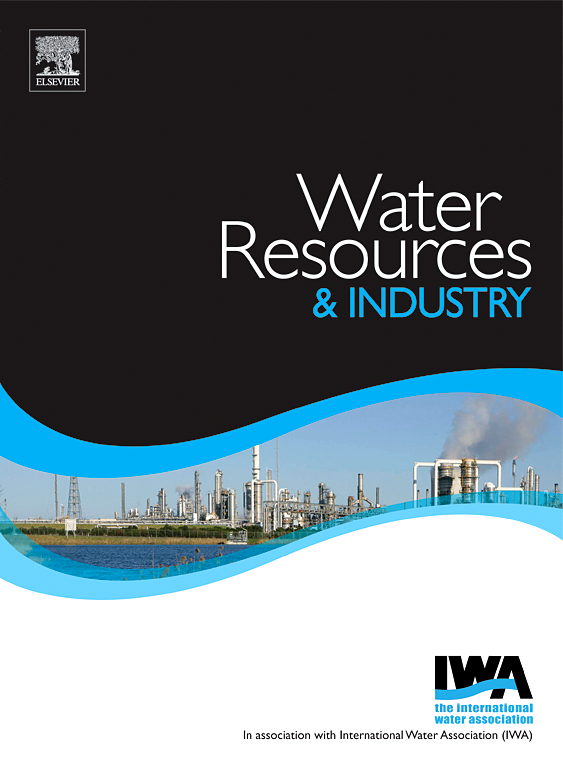Numerical simulations of solid suspensions in a gravity thickener
IF 7.5
3区 工程技术
Q1 WATER RESOURCES
引用次数: 0
Abstract
Reducing the overall water and energy consumptions in deep mines is a necessity in moving toward a more sustainable mining industry. Underground water treatment is a key requirement to achieve this goal. This study numerically investigates the dynamics of a continuous decantation process as a technique to recycle and reuse wastewater in deep mines without pumping it to the surface. A three-dimensional mathematical model that considers the conservation of mass and momentum has been derived, validated, and implemented to simulate the turbulent two-phase flow inside a decantation tank. The validation is achieved by comparing the numerical simulations to experimental data from the literature for two reference cases: (i) turbulent slurry flows (water and glass particles) in a horizontal pipe; (ii) turbulent swirling flow of limestone ore - water in a hydrocyclone. The framework of the validated model has been extended to examine the effect of various design parameters on the efficiency of a full-scale conical-shaped decantation tank (diameter of 1 [m] and total height of 0.97 [m]). The inlet values of flowrate and particle volume concentration are fixed to 50 [GPM] and 4.5 [%], respectively. The diameter and density of the solid particles are equal to 150 [μm] and 1.15, respectively. The results compare the efficiency of 20 different designs of the decantation tank (with/without inner cylinder, scrapers, feedwell, …) in terms of the overflow water quality. The results indicate that the efficiency of the decantation tank increases with inner surface area at fixed volume. Also the plain decanter with scrapers exhibits the highest efficiency, whereas the design with the center extract performs the worst.
重力增稠机中固体悬浮物的数值模拟
为了实现更可持续的采矿业,减少深层矿山的总体水和能源消耗是必要的。地下水处理是实现这一目标的关键要求。本研究通过数值方法研究了连续滗析过程的动力学特性,该过程是一种无需将废水抽至地表即可回收和再利用深部矿井废水的技术。建立了一个考虑质量和动量守恒的三维数学模型,并对其进行了验证和实现,以模拟滗析罐内的湍流两相流动。通过将数值模拟与文献中两种参考情况的实验数据进行比较,验证了这一结论:(i)水平管道中湍流浆体流动(水和玻璃颗粒);(ii)水力旋流器中石灰石矿石水的湍流旋流。对验证模型的框架进行了扩展,以检验各种设计参数对全尺寸锥形滗水罐(直径为1 [m],总高度为0.97 [m])效率的影响。进口流量和颗粒体积浓度分别固定为50 [GPM]和4.5[%]。固体颗粒的直径为150 μm,密度为1.15 μm。结果比较了20种不同设计的倾析池(带/不带内筒、刮刀、进料井等)在溢流水质方面的效率。结果表明:在一定体积下,内表面积越大,滗析池的效率越高;带刮刀的平卧器效率最高,而带中心抽液的设计效率最差。
本文章由计算机程序翻译,如有差异,请以英文原文为准。
求助全文
约1分钟内获得全文
求助全文
来源期刊

Water Resources and Industry
Social Sciences-Geography, Planning and Development
CiteScore
8.10
自引率
5.90%
发文量
23
审稿时长
75 days
期刊介绍:
Water Resources and Industry moves research to innovation by focusing on the role industry plays in the exploitation, management and treatment of water resources. Different industries use radically different water resources in their production processes, while they produce, treat and dispose a wide variety of wastewater qualities. Depending on the geographical location of the facilities, the impact on the local resources will vary, pre-empting the applicability of one single approach. The aims and scope of the journal include: -Industrial water footprint assessment - an evaluation of tools and methodologies -What constitutes good corporate governance and policy and how to evaluate water-related risk -What constitutes good stakeholder collaboration and engagement -New technologies enabling companies to better manage water resources -Integration of water and energy and of water treatment and production processes in industry
 求助内容:
求助内容: 应助结果提醒方式:
应助结果提醒方式:


